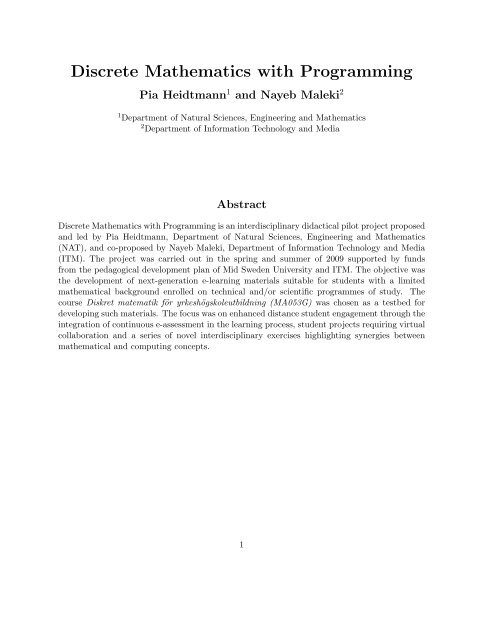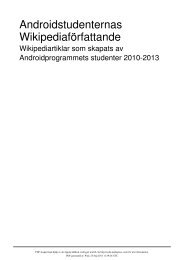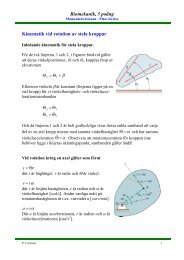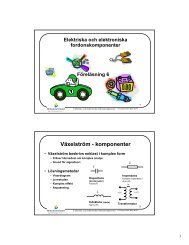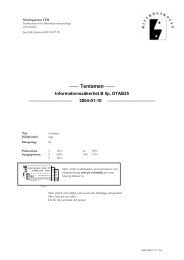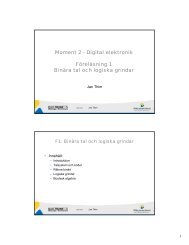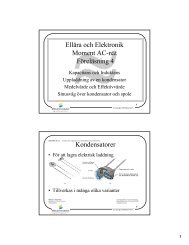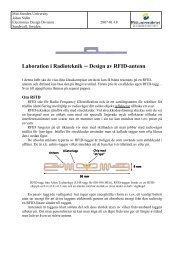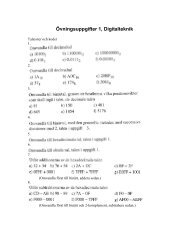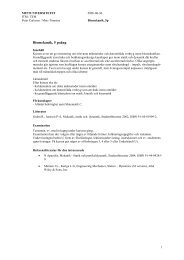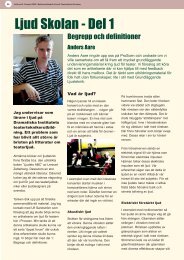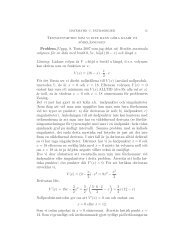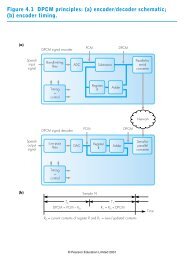Discrete Mathematics with Programming
Discrete Mathematics with Programming
Discrete Mathematics with Programming
You also want an ePaper? Increase the reach of your titles
YUMPU automatically turns print PDFs into web optimized ePapers that Google loves.
<strong>Discrete</strong> <strong>Mathematics</strong> <strong>with</strong> <strong>Programming</strong><br />
Pia Heidtmann 1 and Nayeb Maleki 2<br />
1 Department of Natural Sciences, Engineering and <strong>Mathematics</strong><br />
2 Department of Information Technology and Media<br />
Abstract<br />
<strong>Discrete</strong> <strong>Mathematics</strong> <strong>with</strong> <strong>Programming</strong> is an interdisciplinary didactical pilot project proposed<br />
and led by Pia Heidtmann, Department of Natural Sciences, Engineering and <strong>Mathematics</strong><br />
(NAT), and co-proposed by Nayeb Maleki, Department of Information Technology and Media<br />
(ITM). The project was carried out in the spring and summer of 2009 supported by funds<br />
from the pedagogical development plan of Mid Sweden University and ITM. The objective was<br />
the development of next-generation e-learning materials suitable for students <strong>with</strong> a limited<br />
mathematical background enrolled on technical and/or scientific programmes of study. The<br />
course Diskret matematik för yrkeshögskoleutbildning (MA053G) was chosen as a testbed for<br />
developing such materials. The focus was on enhanced distance student engagement through the<br />
integration of continuous e-assessment in the learning process, student projects requiring virtual<br />
collaboration and a series of novel interdisciplinary exercises highlighting synergies between<br />
mathematical and computing concepts.<br />
1
1 The Context<br />
Nowadays many universities throughout the world are widening participation and are frequently<br />
admitting students <strong>with</strong> a very limited mathematical background to technical or scientific programmes<br />
of study requiring substantial mathematical skills. A plethora of broad, introductory<br />
mathematics courses at basic level have thus emerged in recent years to cater for the needs of<br />
such students. These courses must train the students in the basic mathematical skills of arithmetic<br />
and algebra and acquaint them <strong>with</strong> the more advanced mathematical concepts required<br />
for their programmes of study. The range of new topics that need to be mastered is often quite<br />
large as students start from a low level and so they must follow a very steep learning curve. The<br />
course Diskret matematik för yrkeshögskoleutbildning (DMY) is such a broad first year mathematics<br />
course. Delivery is for distance students only enrolled on the vocational programme<br />
Nätverksdrift/webbapplicationsutveckling 120hp at ITM. DMY is delivered and owned by NAT.<br />
This report is organised as follows. Section 2 discusses the problems <strong>with</strong> the chosen course:<br />
high drop-rates, the limited resources available for course development and unhappy students.<br />
The current status of the project work packages is outlined in Section 3. Extensive details of the<br />
e-learning tools developed are given in Section 4 and finally Section 5 presents our conclusions<br />
including pointers to future developments.<br />
2 The Problem<br />
Prior to the <strong>Discrete</strong> <strong>Mathematics</strong> <strong>with</strong> <strong>Programming</strong> project the DMY course had been a major<br />
cause of concern not only for the course lecturer Pia Heidtmann (PH), but also for the programme<br />
manager Nayeb Maleki (NM). The vocational programme Nätverksdrift/webbapplicationsutveckling<br />
had an extremely low pass rate, and the DMY course was identified as a contributor to this<br />
<strong>with</strong> its very high drop-out rate and only a handful of students passing the course each year in<br />
spite of a good intake rate.<br />
Course evaluations did not have a sufficient uptake among the students to form a statistically<br />
sound basis for a formal study of the reasons behind the failing course. Through extensive<br />
informal discussions <strong>with</strong> the students, emails received and messages exchanged on discussion<br />
forums, it came to light that the underlying issue <strong>with</strong> DMY was a combination of students<br />
<strong>with</strong> a very weak mathematical background and insufficient motivation due to an inability to<br />
comprehend the relevance of mathematical topics in their programme of study. Most students<br />
seemed to perceive the course not only as being impossibly hard but also completely detached<br />
from their other courses.<br />
Based on the feedback from the students, PH identified key areas where new materials and<br />
approaches seemed to be appropriate in order to create a better student experience. She had<br />
initiated a major overhaul of the course material in 2007 and had revised the course plan to<br />
2
accommodate the changes. The revised course plan was accepted by Matematikkollegiet in May<br />
2008. However, resources were severely limited. The mathematics portfolio at NAT had recently<br />
undergone significant restructuring, necessitating major revision of many courses. Funding for<br />
course development was thus in very high demand, and limited resources being shared between<br />
a large number of courses unfortunately could not cater for implementing the overhaul of DMY.<br />
Progress was correspondingly slow <strong>with</strong> the majority of the work being carried out in PH’s spare<br />
time. An opportunity arose in December 2008 for possible funding from the implementation of<br />
the university pedagogical plan for a formal course development, as ITM had funds available for<br />
the required departmental co-financing.<br />
3 The Project<br />
PH and NM proposed for the university to fund the <strong>Discrete</strong> <strong>Mathematics</strong> <strong>with</strong> <strong>Programming</strong><br />
project in an attempt to create a new and exciting DMY distance course which would not be a<br />
financial liability for their departments. The focus was to be on distance student engagement<br />
through the incorporation of continuous e-assessment in the learning process, virtual lectures,<br />
workshops and meetings and a series of novel interdisciplinary exercises in programming and<br />
mathematics. WebCT and Marratech were chosen as a framework for the development as these<br />
are well-established at our university, but the tools developed (cf. Section 4) are easily transferable<br />
to other VLEs and communication tools.<br />
The work programme of the project was structured in work packages (WPs) designed to provide<br />
a continuous workflow <strong>with</strong>in three distinct work phases:<br />
3.1 WP1: Interdisciplinary Discussions<br />
The project started <strong>with</strong> interdisciplinary discussions between the project investigators concerning<br />
the desired course changes. To this extent, initially synergies between discrete mathematics<br />
and computing courses were identified. Based on a set of specifications drawn from the discussions,<br />
PH subsequently designed and implemented interdisciplinary exercises throughout the<br />
DMY course given in the spring of 2009, for the first time giving the students a physical demonstration<br />
of the relevance of mathematics in their main subject areas. Since the course was a<br />
distance course delivered entirely via the web and Marratech, we also combined the idea of interdisciplinarity<br />
<strong>with</strong> continuous e-assessment in the form of computer-marked quizzes, further<br />
continuous assessment through lecturer-marked send-in assignments and small peer-assessed<br />
group projects to enhance student collaboration. Other computing lecturers were kept in the<br />
loop about the contents of the interdisciplinary exercises and were given the opportunity to<br />
comment on them via email to ensure the relevance of the developed materials.<br />
3
3.2 WP2: E-learning Tools<br />
This was by far the largest of the three work packages. PH had to revise the electronic study<br />
guides, develop interdisciplinary exercises and develop the e-assessments for the study blocks. In<br />
the original project proposal we proposed to develop 12 blocks of study. We actually developed<br />
11 blocks of study because feedback from the students during the development phase showed<br />
that the third block developed was so large that they needed more time for it. The large block<br />
is on two subject matters and is thus easily split into two, giving the course the intended 12<br />
blocks. Each block is designed to be roughly one week’s study at quarter-speed and consists of<br />
• a study guide;<br />
• a set of interdisciplinary lab exercises;<br />
• an assessed send-in exercise;<br />
• an e-assessment.<br />
A detailed description of each element in a block of study can be found in Section 4 below.<br />
3.3 WP3: Evaluation and Demonstration<br />
The success of the <strong>Discrete</strong> <strong>Mathematics</strong> <strong>with</strong> <strong>Programming</strong> course is supported by the very<br />
positive feedback from the students and the drastically improved pass rate. Initial results are<br />
very encouraging, indicating that the resulting e-learning environment has radically changed the<br />
student perception of the course.<br />
It was originally intended to evaluate the project during the course of spring 2010, but in a<br />
restructuring of their study programme, the vocational students are now studying their mathematics<br />
in the computing courses, whenever they need it. This means the only testing of the<br />
material so far has been the beta-version of the course in the development phase of the project<br />
in spring 2009.<br />
As in previous years, formal course evaluation questionnaires had a very poor uptake among<br />
the DMY students in spite of the project investigators strongly encouraging them to give formal<br />
feedback due to the novel nature of the course structure. However, in emails and informal<br />
conversations the students have shown appreciation for the course structure and the learning<br />
materials. The drastic improvement in pass rate is probably the best indicator for the level of<br />
success of this project <strong>with</strong> as many students passing in 2009 as had passed in the previous three<br />
academic years combined!<br />
A seminar will be given on 13 April 2010 at Mid Sweden University demonstrating in detail the<br />
materials developed in the project. Furthermore these materials are currently being adapted for<br />
use in two other discrete mathematics courses at a more advanced level. The expectation is to<br />
4
e able to perform a more formal validation and further demonstration of the relevant benefits<br />
to campus students on these courses.<br />
4 The Tools<br />
4.1 Study Guides and Marratech Meetings<br />
It was part of the design to create a flexible learning environment suitable for both synchronous<br />
and asynchronous learning. Each study guide corresponds to approximately one week’s work<br />
for the average student: references to relevant reading in the course book, help for reading<br />
difficult passages, additional material and suggested exercises. The study guides are in HTML<br />
and contain hyperlinks, so unfortunately they cannot be appreciated fully in printed form. The<br />
interested reader is referred to Appendix A for a URL where a sample study guide can be viewed<br />
online.<br />
The course book used was K Eriksson & H Gavel: Diskret matematik och diskreta modeller.<br />
ITM had as a main priority that the students should be given a book in Swedish for this course,<br />
and as the book by Eriksson and Gavel was considered the best of a very small number of<br />
Swedish texts available in the subject, it was chosen back when the DMY course was first designed.<br />
Students have over the years complained that the text is too hard, but the language<br />
requirement was still considered a priority, so it was decided to keep the text and instead enhance<br />
the study guides and accompany each block of study by online lectures via Marratech.<br />
Lectures were recorded and uploaded to WebCT, making it possible to study the course asynchronously<br />
if desired. We had very positive feedback on the recorded Marratech lectures. Many<br />
students on the course are in full-time employment and cannot partake in lectures during the<br />
day, so they used the recordings extensively. Also students who did partake in the live online<br />
lectures used the recordings, listening to difficult passages repeatedly. One drawback <strong>with</strong> online<br />
lectures observed by PH is that students are shy when it comes to speaking on Marratech,<br />
they all prefer putting their comments/questions in writing. Marratech provides a dialogue-box<br />
for exchanging messages, but for the lecturer it makes it hard to get a feeling for whether the<br />
audience is still following the arguments or if they are completely lost. Even using webcams<br />
does not give the same audio/visual feedback as personal contact <strong>with</strong> students in a physical<br />
lecture room. However, on the positive side lectures are recorded, so students can rewind and go<br />
over difficult passages again and again until they have understood them, and this compensates<br />
somewhat for the lack of face-to-face contact. There was supposed to be 18 2-hour sessions on<br />
Marratech, 12 lectures corresponding to the 12 blocks and 6 workshops where we would discuss<br />
problems. In the end we had 21 2-hour sessions and a number of impromptu informal meetings.<br />
We used the meeting time for lectures, sorting out problems, solving exercises, but also<br />
for discussing how things were going and helping people over their feeling of being alone <strong>with</strong><br />
their maths problems. Many a student has told PH that they would not have managed to get<br />
through the course <strong>with</strong>out this personal contact.<br />
5
4.2 Interdisciplinary Lab Exercises<br />
One of the key ideas was to incorporate interdisciplinary exercises highlighting to the students<br />
the use of mathematics in computing subjects, in particular programming. We did this because<br />
feedback from students showed that they seemed to perceive the mathematics course as being<br />
impossibly hard and completely detached from their other courses, and many had cited this as<br />
the reason for giving up on the course.<br />
Designing good interdisciplinary exercises at university level is not an easy task as most lecturers<br />
are experts in one subject only. PH solved the task by drawing on (i) her own background<br />
which includes a combined degree in mathematics and computing, (ii) NM and other lecturers<br />
in computing and (iii) further computing lecturers/researchers of her acquaintance, some from<br />
other universities. The students appreciated the interdisciplinary lab exercises on a meta-level,<br />
acknowledging that they helped them see the connections between the subjects. However, most<br />
gave the feedback that they had looked at them all, but done only a few of them. It should<br />
be noted the exercises were not part of the assessment, as this would have required careful<br />
synchronisation <strong>with</strong> the computing courses, which was not possible in the development phase<br />
of the project. The reader is referred to Appendix B for a sample interdisciplinary lab exercise.<br />
4.3 Assessed Send-in Exercises<br />
For each block of study there was a small send-in exercise. In order to allow asynchronous study<br />
the send-in exercises were submitted in two batches. As <strong>with</strong> assignments on campus courses,<br />
the send-in exercises were corrected by the lecturer and each student given personal feedback<br />
on their work as well as full model solutions. Students submitted send-in exercises via WebCT<br />
and they were also returned by PH via WebCT together <strong>with</strong> a grade. The reader is referred to<br />
Appendix C for a sample send-in exercise.<br />
Students were able to get help for solving exercises from workshops, but in addition to this the<br />
learning environment created also comprised a number of discussion forums on WebCT where<br />
students could get help from each other and the lecturer. Over 300 messages were exchanged<br />
on these forums during the course of spring 2009.<br />
4.4 Continuous e-assessment<br />
The big drop-out rate on the DMY distance course was one of the main problems we wanted to<br />
address in the project. It was decided to tackle the problem by designing the course to heighten<br />
student engagement. Often distance students can feel isolated and lack motivation due to not<br />
having the peer support that campus students benefit from, so one area where we set in was to<br />
create a community spirit around the WebCT course. We had a presentation forum where everybody,<br />
including the lecturer, had to write a bit about themselves. We had general discussion<br />
forums for all kinds of problems/queries arising and we had a maths questions forum for ANY<br />
maths question arising in the course and in their other courses. We also had the aforementioned<br />
6
Marratech meetings.<br />
Apart from this PH constructed a group exercise. Students were divided into groups and had to<br />
choose one of 8 exercises. A couple of these are included in Appendix D. They then had to work<br />
together to solve the exercise. As they all lived at some distance from each other they worked<br />
online via Skype, Marratech, phone, SMS, WebCT discussion forums, email, or any way they<br />
saw fit. The culmination of the student project was a Marratech session where each group of<br />
students would give online seminars of 10-15 minutes about their project and they would hand<br />
in a short report. The project formed part of their assessment, and they were required to ensure<br />
that each group member demonstrated either during the seminar or the report that they had<br />
participated actively in the project. The audience consisted of the lecturer and the students,<br />
and after each presentation the audience would assess it <strong>with</strong> a U, a G or VG. The feedback from<br />
the students was that they enjoyed being giving the responsibility to assess each other. Serious<br />
discussions took place during this Marratech session, and though no presentation was given a<br />
U, presentations were not automatically given a VG either. PH thought it was fantastic to see<br />
how well the students coped <strong>with</strong> presenting slides on the online whiteboard and she enjoyed<br />
very much being part of the audience rather than the speaker at this session.<br />
Finally, after each block the students were invited to do a computer-assessed quiz on WebCT.<br />
The quizzes were supposed to be part of the learning process as well as part of the assessment on<br />
the course, so they were allowed as many attempts as they liked, but all attempts were logged<br />
and in the final assessment a weighted average of the results <strong>with</strong> heavy emphasis on the first<br />
attempt counted towards the course grade. The quizzes provided feedback in the form of marks,<br />
but also hints and solutions. Sample questions and feedback from some of the quizzes can be<br />
seen in Appendix E. Many students worked really hard <strong>with</strong> these tests, doing them once, then<br />
working through the answers and trying again. PH is sorry to report that she also detected<br />
what may be a less honourable student, on a number of tests scoring 0 points in an attempt<br />
lasting 10 seconds followed by a score of 100% in the same quiz a few minutes later. However,<br />
this was the exception.<br />
Before the project, DMY had continuous assessment in part in the form of a couple of send-in<br />
exercises which would count towards the course grade in the form of bonus points. The main<br />
assessment was a 5 hour written paper and the course grade was based on a combination of the<br />
performance on the written paper and the bonus points obtained. The students of spring 2009<br />
could choose this method of assessment if they wanted. PH designed a scheme for converting<br />
coursework marks into bonus points for this purpose.<br />
One thing which had come to light over the years was the DMY students’ almost phobic angst<br />
for the maths tenta, they would often start the first day of the first week of course by categorically<br />
stating that ’I cannot understand the f...... maths’ either in a meeting or on a discussion<br />
forum. ’I am never going to be able to pass this course, I am going to tell Nayeb I want to<br />
quit’ was also heard too many times. So PH decided after conferring <strong>with</strong> Klas Forsman, the<br />
7
Director of Studies for <strong>Mathematics</strong>, that on a trial-basis she would allow the DMY students of<br />
spring 2009 the option to be assessed on participation and coursework alone, if they so desired.<br />
Further, they were given a ’free’ attempt at bettering their grades in that their course grade<br />
on the course would be their coursework grade or their tenta grade, whichever was the higher.<br />
This was done in order to encourage them to sit the tenta, as it is well known that during tenta<br />
revision many topics really root in student brains. Perhaps surprisingly most students decided<br />
not to sit the ’free’ tenta, supporting the theory of phobic angst suggested above. The complete<br />
method of assessment of the course of spring 2009 can be found in Appendix F.<br />
5 Conclusions and Future Developments<br />
The funding for the <strong>Discrete</strong> <strong>Mathematics</strong> <strong>with</strong> <strong>Programming</strong> project enabled us to develop a<br />
set of novel tools and approaches for teaching mathematics to computing students coming into<br />
university programmes of study <strong>with</strong> limited mathematical background. The feedback from<br />
the students during the beta-run in spring 2009 has been encouraging and we have thus already<br />
started adapting the tools and the resulting learning environment for use in other relevant<br />
courses.<br />
The <strong>Discrete</strong> <strong>Mathematics</strong> <strong>with</strong> <strong>Programming</strong> project shows what resource-based learning can<br />
achieve given sufficient resources. However, <strong>with</strong> a student base of around 30 students, a lecturer<br />
would not be allocated sufficient time to be able to prepare and give all the Marratech lectures,<br />
maintain the discussion boards and set and mark send-in exercises, even <strong>with</strong> a fully developed<br />
teaching material, so cuts will have to be made in the format to make the course format more<br />
realistic. PH is working on this aspect at the moment in her adaptation of the core elements of<br />
the project in other courses.<br />
PH has in the autumn of 2009 and spring of 2010 adapted the format and layout of the WebCT<br />
course in the three distance courses MA055G Matematisk introduktionskurs, MA025G Linjär<br />
Algebra I and MA057G Översiktskurs i Analys, and some of her experiences are helping in the<br />
design of a mathematics course for a new vocational study programme for processoperatörer <strong>with</strong><br />
a student base similar to that of DMY. PH also continues the development of the e-assessment<br />
material and some of the interdisciplinary lab exercises in the current <strong>Discrete</strong> <strong>Mathematics</strong><br />
courses MA001G and MA064G, both of which are campus courses, but <strong>with</strong> an added VLE<br />
component, making them blended learning environments.<br />
The ultimate vision is to have a flexible set of easily customisable e-learning tools suitable for a<br />
range of courses requiring a mathematical background at a variety of levels. Such tools would be<br />
very valuable in today’s fast moving teaching landscape in higher education institutions where<br />
programmes of study have to be adaptable to the needs of a fast moving society.<br />
8
Appendices<br />
A URL of a Sample Study Guide<br />
A sample study guide can be viewed online at<br />
http://apachepersonal.miun.se/∼piahei/dismatprog/sampleguide.html<br />
or by enrolling and logging on to the <strong>Discrete</strong> <strong>Mathematics</strong> <strong>with</strong> <strong>Programming</strong> demo course in<br />
WebCT (cf. Appendix G).<br />
B A Sample Interdisciplinary Lab Exercise<br />
Below is one of the lab exercises from the DMY course given in spring 2009. It is taken from<br />
Block 3 of the course.<br />
Lab Exercise 1<br />
A computer science lecturer asked his students to write a fragment of Java code which prints<br />
out all the odd integers between 1 and 100.<br />
To the shock of the lecturer, one student handed in the following solution:<br />
System.out.println("1"); System.out.println("3"); System.out.println("5");<br />
System.out.println("7"); System.out.println("9"); System.out.println("11");<br />
System.out.println("13"); System.out.println("15"); System.out.println("17");<br />
System.out.println("19"); System.out.println("21"); System.out.println("23");<br />
System.out.println("25"); System.out.println("27"); System.out.println("29");<br />
System.out.println("31"); System.out.println("33"); System.out.println("35");<br />
System.out.println("37"); System.out.println("39"); System.out.println("41");<br />
System.out.println("43"); System.out.println("45"); System.out.println("47");<br />
System.out.println("49"); System.out.println("51"); System.out.println("53");<br />
System.out.println("55"); System.out.println("57"); System.out.println("59");<br />
System.out.println("61"); System.out.println("63"); System.out.println("65");<br />
System.out.println("67"); System.out.println("69"); System.out.println("71");<br />
System.out.println("73"); System.out.println("75"); System.out.println("77");<br />
System.out.println("79"); System.out.println("81"); System.out.println("83");<br />
System.out.println("85"); System.out.println("87"); System.out.println("89");<br />
System.out.println("91"); System.out.println("93"); System.out.println("95");<br />
System.out.println("97"); System.out.println("99");<br />
Another student used a for-loop construction and handed in the following (two-line) solution:<br />
9
int n = 50;<br />
for (int i=0 ; i
explain to a computer what ”. . .” or ”and so on” means. Compare <strong>with</strong> the two programs above.<br />
You would probably need to tell the computer that the numbers are integers and find some way<br />
of explaining to it what it means for an integer to be odd. Hence you might as well use notation<br />
3...<br />
C A Sample Send-in Exercise<br />
Below is a sample send-in exercise used on the DMY course in the spring of 2009. The students<br />
were given individual feedback on their work and full solutions to all exercises.<br />
11
D Two Sample Group Exercises<br />
Below are two of the group exercises used on the DMY course in the spring of 2009. The student<br />
groups choosing the exercises managed to solve these.<br />
Uppgift 01: Svart eller vit?<br />
Det finns 75 vita och 150 svarta kulor i en stor urna. Bredvid urnan är en stor hög av svarta<br />
kulor. Man gör följande tv˚a-stegsoperation upprepade g˚anger.<br />
1. Ta tv˚a kulor utifr˚an urnan.<br />
2. Om<br />
• b˚ada kulorna är svarta, lägg en tillbaka i urnan, och kasta bort den andra;<br />
• en är svart och en är vit, lägg den vita tillbaka i urnan och kasta bort den svarta;<br />
• b˚ada kulorna är vita, kasta bort dem och lägg en svart fr˚an högen bredvid urnan i<br />
urnan.<br />
(Du f˚ar anta att det alltid finns svarta kulor i högen.)<br />
Varje g˚ang man gör tv˚a-stegsoperationen tar man tv˚a kulor utifr˚an urnan, och stoppar in en.<br />
Det betyder att antal kulor i urnan g˚ar ner med en varje g˚ang. Slutligen finns det bara en kula<br />
i urnan.<br />
Vilken färg har den? Motivera svaret!<br />
Uppgift 02: Färgläggning<br />
Ta en stor kvadrat och rita n˚agra räta linjer fr˚an kant till kant var som helst. Nu finns det n˚agra<br />
ytor inom kvadraten. Idéen är att färga alla ytor s˚a att inga grannar har samma färg. (Tv˚a<br />
ytor som endast har en gemensam punkt betraktas inte som grannar.)<br />
Vad är det minsta antal färger som behövs? Motivera svaret!<br />
12
E Screenshots of Sample e-assessment Exercises and Feedback<br />
13
F Assessment Method<br />
The assessment method used on the DMY course in the spring of 2009 was explained to the<br />
students as follows.<br />
The grade on this course is the higher of two grades: one grade you will be awarded for your<br />
coursework and the other you will be awarded for the June tenta. It is thus possible to pass the<br />
course by doing all the coursework to a satisfactory standard.<br />
Coursework<br />
To each of the 12 blocks of study on the course there are two pieces of coursework to be completed:<br />
an online self-assessment test in WebCT which the computer will mark for you and give<br />
you feedback on and a send-in assignment which must be submitted to the lecturer via WebCT.<br />
The lecturer will mark your send-in assignment and give you feedback on your performance.<br />
In addition to this there will be a group project which you must solve in groups of 2 - 4 students<br />
and present in a Marratech meeting some time in May and on which each group must also hand<br />
in a report. Note that nobody will be allowed to do the group project alone, nor are groups of<br />
more than 4 people allowed. A forum has been set up on WebCT which will allow you to create<br />
groups. You should do this as soon as possible, so that you have the group established before<br />
the group exercise is published.<br />
Grades<br />
Coursework Grades<br />
For your performance on the coursework, including the group project, the lecturer will give you<br />
a grade between A and F based on your performance. Students who do not complete all the<br />
coursework will be awarded the grade F for their coursework and will have to sit the June tenta<br />
in order to pass the course.<br />
Even if you do not complete all the coursework, it is still worth completing as much of it as<br />
you possibly can. You will be awarded up to 4 bonus points according to how much of the<br />
coursework you have done. These bonus points are valid on the tenta in June (see below) and<br />
the omtenta in August.<br />
For administrative reasons, if you do not sign up for the June tenta you cannot pass the course,<br />
so your coursework grade will automatically be reset to F, only your bonus points will be carried<br />
forward to the August omtenta. So remember to sign up for the tenta!<br />
15
Tenta Grades<br />
You will have up to 4 bonus points <strong>with</strong> you for the tenta from your coursework, depending on<br />
how much of it you have done, and these bonus points will count towards your grade on the<br />
tenta (but only for the tenta in June and the first omtenta in August, from the second omtenta<br />
the bonus points will be reset to 0). The tenta is a written 5 hour paper. In June we will do<br />
the tenta as a ’hemtenta’. The August and October omtentas are ’salstentor’.<br />
You will get one of the grades A, B, C, D, E, Fx and F on the tenta. A grade A - E is a<br />
pass, grade Fx means you have failed, but you will be given a resttenta. Grade F is a fail.<br />
There will be 24 points on the tenta (usually 8 questions of 3 points each). In addition to<br />
this there will be an optional, harder and/or more theoretical, question.<br />
You will always obtain as high a grade on the tenta as possible. If you score e points out<br />
of the 24 on the exam and have b out of the 4 bonus points, you will get<br />
Grade A<br />
if e + b ≥ 24<br />
if e + b ≥ 20 AND you have a good answer to the optional question<br />
Grade B<br />
if e + b ≥ 20<br />
if e + b ≥ 15 AND you have a good answer to the optional question<br />
Grade C<br />
if e + b ≥ 14<br />
ife + b ≥ 12 AND you have made a good attempt at the optional question<br />
Grade D<br />
if e + b ≥ 10<br />
if e + b ≥ 9.5 AND you have made a good attempt at the optional question<br />
Grade E<br />
if e + b ≥ 9<br />
Grade Fx<br />
if e ≥ 8.5<br />
Grade F<br />
if e + b < 9 and e < 8.5.<br />
16
Only in exceptional circumstances where a student demonstrates clearly that he/she has not<br />
met the learning outcomes on the course, will the tenta grade deviate from this table.<br />
Your Grade on the Course<br />
Your grade on the course will be your coursework grade or your tenta grade, whichever is the<br />
higher.<br />
If you sign up for the June tenta but do not sit it, the grade for your course will be your coursework<br />
grade.<br />
Passing on coursework is an option for the June tenta only! You may still do the exam in June,<br />
even if your coursework mark is a pass-grade. Your grade on the course will be the higher of<br />
your coursework grade and your exam grade. If you fail the exam in June and your coursework,<br />
any bonus points you have will be carried forward to the August tenta.<br />
If you do not pass in June or August, your bonus points will also be reset to 0, so from the<br />
second omtenta onwards your grade will be based on the tenta mark only.<br />
17
G <strong>Discrete</strong> <strong>Mathematics</strong> <strong>with</strong> <strong>Programming</strong> -<br />
The Project as a Resource<br />
A copy of this project report can viewed online at<br />
http://apachepersonal.miun.se/∼piahei/dismatprog/dmpreport.pdf<br />
All the course material developed in the <strong>Discrete</strong> <strong>Mathematics</strong> <strong>with</strong> <strong>Programming</strong> project can<br />
be viewed freely by anyone registering on the demo course in WebCT at http://webct6.miun.se<br />
The course is called<br />
Diskret matematik med programmering - utvecklingskurs - DISMAT PROG UTV<br />
and allows self-registration via<br />
Kurslista > Ej kategoriserat > Övriga kurser > DISMAT PROG UTV<br />
Once registered, users can log directly into the course by using the URL:<br />
https://webct6.miun.se/webct/logon/295885702001<br />
A forum for queries/discussions has been set up at the WebCT site. Anybody <strong>with</strong> an interest<br />
is invited to join.<br />
If you have problems <strong>with</strong> self-registration on the course, you may contact helpdesk@miun.se<br />
and ask them to help you register on the course.<br />
Queries of a technical nature concerning how the learning materials were produced may be sent<br />
via email to Pia.Heidtmann@miun.se<br />
18


